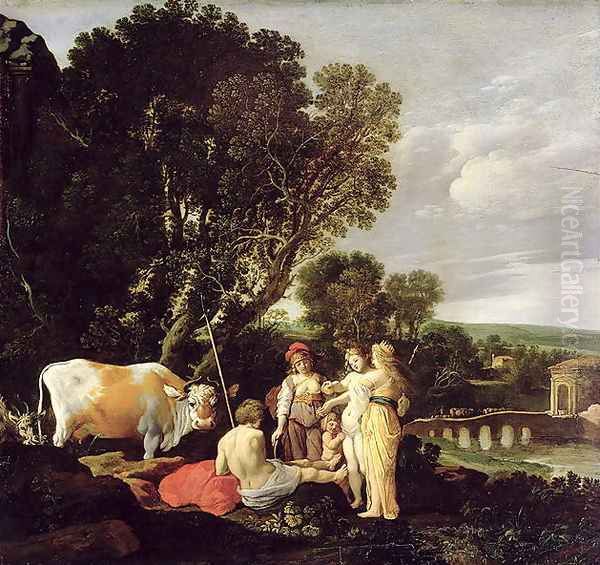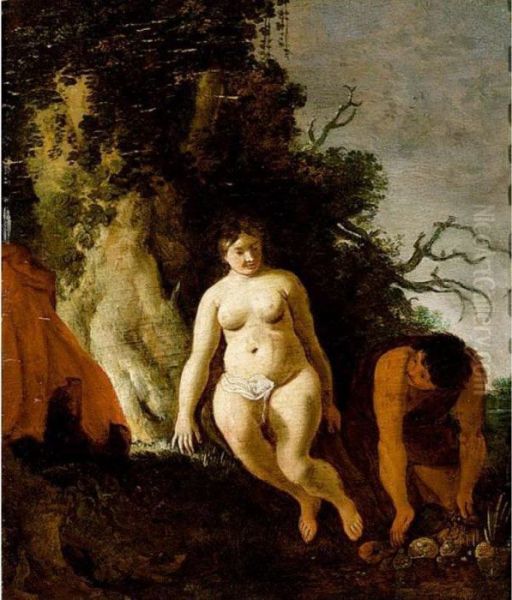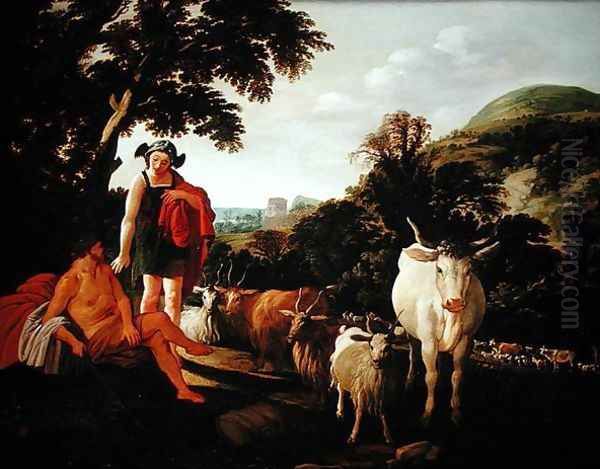Moyses van Uyttenbroeck, also frequently recorded as Moses van Wtenbrouck, stands as an intriguing figure in the rich tapestry of Dutch Golden Age art. Active during the first half of the 17th century, he carved a distinct niche for himself with his evocative depictions of biblical, mythological, and pastoral scenes, often set within meticulously rendered landscapes. Though perhaps not as universally recognized as some of his towering contemporaries, Uyttenbroeck's work reveals a unique artistic vision, a skillful hand, and a fascinating synthesis of native Dutch traditions with Italianate influences. His contributions to the development of landscape and history painting in the Netherlands are significant, meriting closer examination.
Navigating Names and Origins
The artist's name itself presents a common challenge for art historians dealing with this period: variations in spelling. "Moses van Uyttenbroeck" is generally considered the most accurate primary spelling, while "Moyses van Wtenbrouck" appears as a very common and accepted alias, often used interchangeably in historical records and modern scholarship. He was also reportedly surnamed "Little Moses," perhaps a term of endearment or a reference to his stature or specialization in biblical themes involving the prophet Moses.
Born around 1590, or perhaps in the early 1590s, in the historic city of Delft, Uyttenbroeck emerged during a period of extraordinary artistic ferment in the newly independent Dutch Republic. Delft, known for its pottery and breweries, was also a burgeoning center for painters. While details of his earliest training remain somewhat obscure, his formative years would have exposed him to the burgeoning Dutch artistic identity, which was increasingly focused on realism, everyday life, and the local landscape, alongside the more traditional religious and historical subjects.
Early Influences and Artistic Formation
The artistic environment of the early 17th-century Netherlands was dynamic. While some artists were pioneering purely Dutch genres, many, including Uyttenbroeck, looked south to Italy for inspiration, either through travel or through the works of artists who had made the journey. Two key figures often cited as significant influences on Uyttenbroeck's early development are Adam Elsheimer and Paul Bril.

Adam Elsheimer, a German painter active in Rome, was renowned for his small-scale cabinet paintings on copper, characterized by their poetic landscapes, dramatic lighting (chiaroscuro), and meticulous detail. His innovative approach to biblical and mythological narratives within atmospheric settings resonated deeply across Europe. Paul Bril, a Flemish painter who also spent most of his career in Rome, was a leading figure in landscape painting, transitioning from a late Mannerist style to a more classical, idealized form of landscape that would heavily influence Dutch Italianate painters.
It is widely believed, though not definitively proven with contemporary documentation, that Uyttenbroeck was a student of Cornelis van Poelenburch. Poelenburch, born in Utrecht, was a leading figure among the first generation of Dutch Italianate landscape painters. He spent a significant period in Rome, absorbing the influence of Elsheimer and Bril, and became known for his polished, small-scale landscapes, often populated with biblical or mythological figures, rendered with a smooth, enamel-like finish. If Uyttenbroeck did study with Poelenburch, it would have provided a direct conduit for these Italianate ideals.
A Career in The Hague
While his early life was rooted in Delft, and some sources mention activity in Amsterdam, Moyses van Uyttenbroeck's mature career primarily unfolded in The Hague. He is documented as having moved there, likely in the 1620s, and by 1627 he was a member of the Confrerie Pictura, the city's guild of painters. His standing within the artistic community of The Hague grew, evidenced by his later roles as dean (hoofdman) of the Guild of St. Luke in 1638, a position of considerable respect and responsibility.
The Hague, as the seat of the Dutch government and the court of the Princes of Orange, offered a different milieu than the more commercially driven Amsterdam. Patronage from the court and the city's elite was a significant factor for artists. Indeed, Uyttenbroeck found favor with Prince Frederick Henry of Orange, a notable patron of the arts, for whom he executed several commissions. This connection underscores the esteem in which his work was held. His artistic output, while not vast—with current estimates suggesting around sixty known paintings and a number of etchings—demonstrates a consistent quality and a developing personal style. He passed away in The Hague, with sources suggesting either 1648 or 1650 as the year of his death.
Artistic Style: A Blend of North and South
Moyses van Uyttenbroeck's art is characterized by its fusion of Dutch observational detail with an Italianate sense of idealized landscape and classical subject matter. He specialized in history painting, a genre that, according to the art theory of the time, held the highest rank, encompassing biblical narratives, mythological tales, and scenes from ancient history.

His landscapes are rarely empty; they serve as stages for human or divine drama. These settings are often lush and verdant, featuring rolling hills, ancient ruins, and carefully observed foliage. There's a palpable sense of atmosphere in his work, achieved through a sophisticated use of light and shadow – chiaroscuro – which he employed to model figures, create depth, and imbue his scenes with a particular mood, often one of pastoral tranquility or subtle mystery. The light in his paintings often has a warm, golden quality, reminiscent of the Italian Campagna, even when depicting scenes that are ostensibly set elsewhere.
His figures, whether they are shepherds, nymphs, satyrs, or biblical personages, are typically rendered with a degree of classical grace, though they retain a certain Dutch earthiness. Compositions are carefully constructed, often leading the viewer's eye through diagonals and carefully placed elements within the landscape. He demonstrated a particular fondness for themes from Ovid's Metamorphoses and pastoral idylls, alongside popular Old Testament stories.
Compared to some of his contemporaries like the Pre-Rembrandtists Pieter Lastman or Jan Pynas, who also tackled historical and biblical subjects with Italianate influences, Uyttenbroeck's figures are often more integrated into the landscape, which plays a more co-equal role in the narrative. His approach differs from the starker realism of pure landscape painters like Jan van Goyen or the dramatic intensity of Rembrandt's history paintings, occupying a middle ground that emphasizes harmony and a lyrical quality.
Signature Works and Thematic Concerns
Several key works illuminate Uyttenbroeck's artistic preoccupations and stylistic traits. His "Landscape with Mythological Figures" (1628), for instance, showcases his ability to weave narrative into a richly imagined environment. The painting often features classical ruins, a common motif for Italianate painters, symbolizing the passage of time and the enduring power of myth. The figures, perhaps a nymph and a shepherd, are set within a landscape that invites the viewer to explore its depths, with light and texture guiding the eye.
A recurring theme in his oeuvre is "Pan and Syrinx," derived from Ovid. One such painting, sometimes titled "Satyr and Nymph" or simply "Satyr," (c. 1630-1635) depicts the moment before Pan's pursuit of the nymph Syrinx, who would later be transformed into reeds to escape him. Uyttenbroeck often imbued such scenes with a gentle eroticism and a deep appreciation for the natural world, with the river and reeds playing almost character-like roles.

"The Mocking of Ceres" (or "Messapian Shepherds Mocking a Group of Nymphs" as one variant is titled) is another subject he returned to, depicting the goddess Ceres being derided by mortals. This theme allowed him to explore human folly and divine power within a pastoral setting. Interestingly, some of his works, like a version of "Messapian Shepherds Mocking a Group of Nymphs," have faced attribution challenges, having been misattributed to other artists before being correctly identified as Uyttenbroeck's, highlighting the complexities of connoisseurship for artists of this period.
His biblical scenes are equally compelling. He painted subjects such as "Moses Striking the Rock," "The Meeting of Jacob and Rachel," and "Tobias and the Angel." An etching of "Tobias and the Angel" by Uyttenbroeck was notably adapted into an engraving by Jan van de Velde II, a prominent printmaker, indicating the circulation and appreciation of Uyttenbroeck's compositions among his contemporaries. "The Festival of Bacchus" demonstrates his skill in handling more boisterous, multi-figure compositions, filled with mythological revelry.
The painting "The Judgement of Paris" is another work sometimes associated with Uyttenbroeck, though its attribution has been debated. If by his hand, it would fit well within his mythological repertoire, depicting the fateful beauty contest between Juno, Minerva, and Venus. The uncertainty surrounding such attributions is not uncommon for artists with a relatively small and not always consistently documented output.
Contemporaries and the Artistic Milieu of The Hague
Uyttenbroeck worked within a vibrant artistic community. His connection to Cornelis van Poelenburch, whether as a student or simply a close contemporary, is crucial. Poelenburch, along with Bartholomeus Breenbergh, formed the core of the first generation of Dutch Italianate painters. Breenbergh, also active in Rome and later Amsterdam, shared with Poelenburch and Uyttenbroeck a penchant for sunny, Italianate landscapes populated with biblical or mythological figures, though Breenbergh's style often featured more dramatic ruins and a slightly more robust figure style.
In The Hague, Uyttenbroeck would have been aware of artists like Jan van Ravesteyn, a leading portraitist, and later, Adriaen Hanneman, who brought a Van Dyckian elegance to court portraiture. While their genres differed, the presence of a thriving artistic guild fostered interaction and shared standards. Leonard Bramer, a Delft contemporary who also painted historical and biblical scenes, though with a more tenebrous and idiosyncratic style, represents another facet of the period's artistic production.
The broader Dutch art scene included figures like Esaias van de Velde, an early pioneer of realistic Dutch landscape painting, whose work offered a contrast to the Italianate mode. Jan van Goyen, active in The Hague from the 1630s, became a master of the tonal landscape, capturing the Dutch countryside with remarkable subtlety. The imaginative and enigmatic landscapes of Hercules Segers also represent a unique strain in Dutch art.
While Rembrandt van Rijn, a towering figure based primarily in Leiden and then Amsterdam, focused on a more profound psychological depth in his history paintings and portraits, his early works, influenced by Pieter Lastman, share some common ground with Uyttenbroeck in terms of subject matter and the assimilation of Italianate compositional ideas. Lastman himself, Rembrandt's teacher, was a key figure in popularizing history painting in Amsterdam, drawing heavily on his Italian experiences and the work of artists like Elsheimer. The Pynas brothers, Jan and Jacob, were also significant history painters in this vein.
The engraver Jan van de Velde II, who reproduced Uyttenbroeck's "Tobias and the Angel," was part of a prolific family of artists and played a vital role in disseminating compositions through prints. This interaction between painters and printmakers was essential for the spread of artistic ideas. Even the tentative connection to Claes Jacobsz. van der Gucht, through the disputed attribution of "The Judgement of Paris," points to the network of artists whose styles might occasionally converge or be confused by later generations. For contrast, one might also consider the Utrecht Caravaggisti, such as Dirck van Baburen and Hendrick ter Brugghen, who brought a dramatic, realist interpretation of Caravaggio's style back to the Netherlands, primarily influencing religious and genre scenes.
Art Historical Standing and Unresolved Questions
Moyses van Uyttenbroeck occupies a specific and noteworthy place in Dutch art history. He was a skilled practitioner of the Italianate landscape with figures, a genre that enjoyed considerable popularity, especially among more sophisticated patrons who appreciated its classical allusions and refined aesthetics. His ability to create harmonious compositions, imbued with a gentle, poetic light, marks him as a distinctive talent.
However, his legacy is not without its complexities. The relatively small number of surviving works—around sixty paintings and a handful of etchings—means his oeuvre is less extensive than that of some of his more prolific contemporaries. This scarcity, while making each piece more precious, can also make it harder to fully assess the trajectory of his development and his overall impact.
Attribution issues, as seen with "The Judgement of Paris" or the initial misattribution of other works, are part of his story. Such uncertainties are common for artists who were not meticulously documented by early biographers like Karel van Mander (who wrote too early for Uyttenbroeck) or Arnold Houbraken (who might have overlooked him or had limited information).
There's also the historical hierarchy of genres to consider. While history painting was theoretically esteemed, landscape painting as an independent genre was rapidly gaining ground and popularity in the Netherlands. Uyttenbroeck's work, often a hybrid, might have been seen by some contemporaries as a slightly less "serious" form of history painting if the landscape element was perceived to dominate, or as a more "elevated" form of landscape due to its narrative content. The very fact that his landscapes often "required" classical or biblical figures to be considered complete by the standards of the day speaks to this evolving artistic landscape.
Some anecdotes or mysteries persist. The nickname "Little Moses" is intriguing but its precise origin is unknown. There are also mentions of lost works, such as a painting titled "Orpheus, die Tiere beängstigend" (Orpheus Charming the Animals), which, if rediscovered, could further illuminate his thematic range and stylistic capabilities. The precise details of his training and the full extent of his interactions with other artists remain areas for ongoing scholarly investigation.
Conclusion: An Enduring Charm
Moyses van Uyttenbroeck, or Moses van Wtenbrouck, remains a captivating artist whose works offer a delightful window into a particular current of Dutch Golden Age painting. He successfully navigated the artistic currents of his time, blending the burgeoning Dutch interest in landscape with the enduring appeal of classical and biblical narratives, all filtered through an Italianate sensibility for light and idealized form. His paintings, though not numerous, are characterized by their lyrical charm, technical finesse, and harmonious integration of figure and setting.
While he may not have achieved the revolutionary impact of a Rembrandt or the widespread fame of a Vermeer, Uyttenbroeck was a respected master in his own right, patronized by the court and active in the artistic leadership of The Hague. His art provides a crucial link in understanding the development of Italianate landscape painting in the Netherlands and the diverse ways in which Dutch artists responded to both their local environment and the broader European artistic heritage. For those who appreciate the subtle poetry of pastoral scenes, the timeless allure of myth, and the golden light of an imagined Arcadia, the works of Moyses van Uyttenbroeck continue to hold a quiet but persistent appeal.